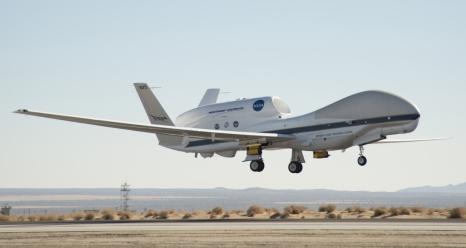A NASA Global Hawk recently completed a checkout flight of science instruments to be used in the Airborne Tropical Tropopause Experiment.
News
Enormous Aquifer Discovered Under Greenland Ice Sheet

Using data from NASA's Operation IceBridge airborne campaign, a large liquid water reservoir buried underneath compacted snow and ice in Greenland has now been mapped.
NASA Snow Mapper Reaps Big Benefits for California

A new NASA airborne mission has created the first maps of the entire snowpack of two major mountain watersheds in California and Colorado, producing the most accurate measurements to date of how much water they hold.
NASA Pilots Train for Antarctic Flying
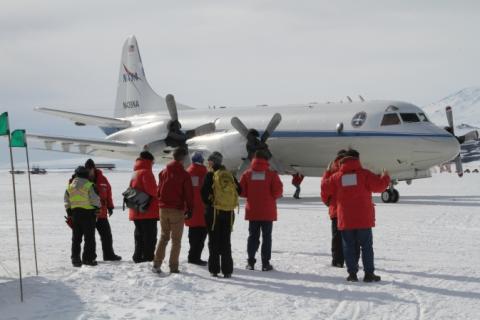
Before IceBridge's Antarctic campaign, NASA P-3 research aircraft pilots and flight engineers got extra training that simulated landing and taking off on a sea ice runway.
Airborne Science Program Trailer
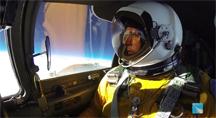
The latest video on the ATTREX mission features footage taken at 70,000 ft from the ER-2 cockpit. This and other videos on the mission can be found at http://www.youtube.com/user/sciflychannel.
NASA Aircraft Collects Data On Earth's Ecosystems

NASA's ER-2 high-altitude research aircraft wrapped up the fall 2013 series of flights during the first week in December for the Hyperspectral Infrared Imager, or HyspIRI, airborne campaign.
Airborne Radar Looking Through Thick Ice

The bedrock hidden beneath the thick ice sheets covering Greenland and Antarctica has intrigued researchers for years. Scientists are interested in how the shape of this hidden terrain affects how ice moves -- a key factor in making predictions about the future of these massive ice reservoirs and their contribution to sea level rise in a changing climate.
NASA's HS3 Hurricane Mission Highlights

NASA's Hurricane and Severe Storm Sentinel airborne mission known as HS3 wrapped up for the 2013 Atlantic Ocean hurricane season at the end of September, and had several highlights. HS3 will return to NASA’s Wallops Flight Facility in Wallops Island, Va., for the 2014 Atlantic hurricane season.
IceBridge at McMurdo: A Year and a Half of Planning
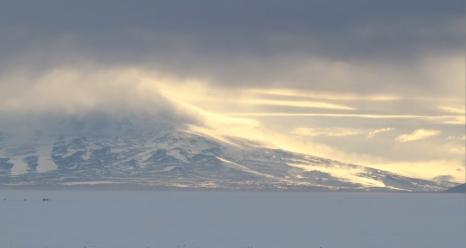
Making the current NASA Operation IceBridge campaign – the first to ever operate directly from Antarctica – a reality took a year and a half of planning and coordination, finishing with weeks of intense work both at home and in Antarctica.
Three in a Row for NASA's IceBridge
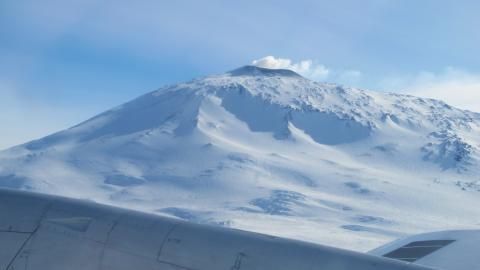
Researchers with NASA's Operation IceBridge kicked off this year's Antarctic campaign with three consecutive science flights.
NASA Aircraft Images Japanese, Hawaiian Volcanoes

NASA's C-20A Earth science aircraft carrying a specialized synthetic aperture radar system has wrapped up a short mission to image Japanese volcanoes.
IceBridge's First Antarctic Campaign from McMurdo Station

The IceBridge mission will conduct daily survey flights through Nov. 26 on a NASA P-3 research aircraft from a base of operations at McMurdo Station.
IceBridge Prepares for Mission of "Firsts"
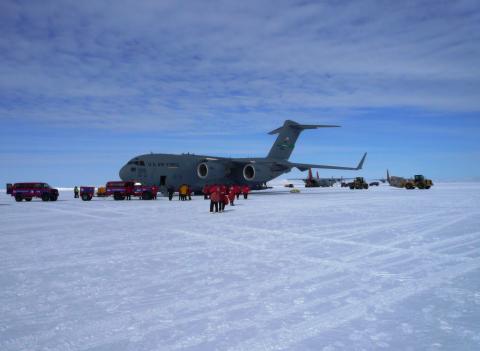
Members of the IceBridge team arrived at McMurdo Station Nov. 12, 2013 aboard a U.S. Air Force C-17 transport aircraft.
NASA's DC-8 Flying Lab Undergoes Major Maintenance
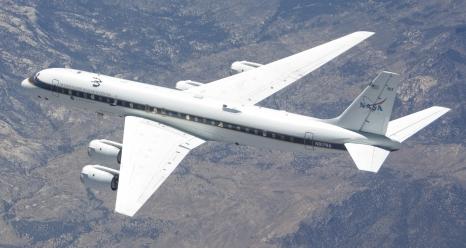
NASA's DC-8 Flying Laboratory will soon undergo "C Check" major maintenance as part of the aircraft’s new Low Utilization Maintenance Plan.
Airborne Campaign to Map Greenland Ice Sheet Summer Melt Begins
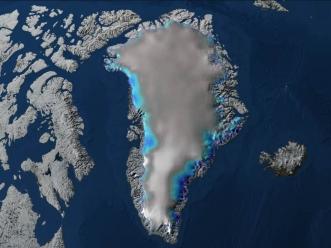
Operation IceBridge will carry out a first-ever campaign to gather data on changes in Greenland's ice following the summer melt season.
NASA Airborne Science Aircraft Complete Summer Deployments
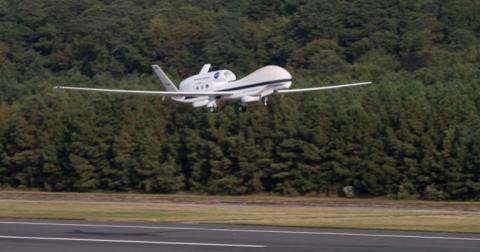
Several NASA Airborne Science aircraft that were deployed for science missions during the summer of 2013 to study subjects from hurricane formation to forest fires have returned to their home bases at NASA's Dryden Flight Research Center and the Dryden Aircraft Operations Center in Southern California.
NASA's Global Hawks Mark 100th NASA Flight
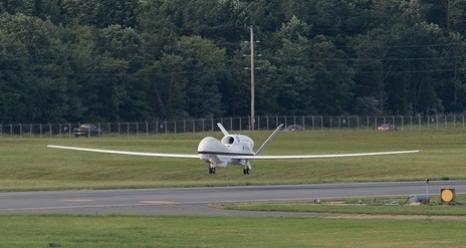
High-flying, long-range aircraft mark milestone Sept. 17 while flying over the Atlantic on the HS3 hurricane formation and intensification mission.
Measurements Underway in Houston for DISCOVER-AQ

Students and researchers from Millersville University, Penn State University and NASA are collaborating at Smith Point, one of the DISCOVER-AQ ground stations near Houston, Texas.
NASA HS3 Mission Animations Peer in and Outside of Tropical Cyclones
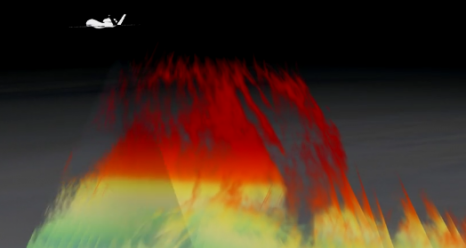
NASA's Hurricane and Severe Storms Sentinel or HS3 mission is flying two unmanned aircraft to explore tropical cyclones and their environment.
NASA Investigates Gabrielle's Remnants and New Tropical Storm Humberto
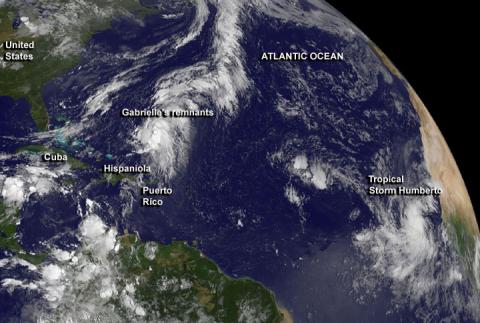
The remnants of the once-tropical-storm Gabrielle continued to struggle near the Bahamas as NASA's HS3 mission investigated.
Global Hawk Data Used in National Hurricane Center Forecast of Gabrielle

Data from the dropsondes that are dispersed from one of NASA's Global Hawk unmanned aircraft assisted forecasters at the National Hurricane Center when analyzing the environment of newborn Tropical Storm Gabrielle at 11 p.m. EDT on Sept. 4.
NASA Data Reveals Mega-Canyon under Greenland Ice Sheet

A study using data primarily from NASA's Operation IceBridge has found a canyon in the bedrock beneath Greenland's ice sheet that is longer than the Grand Canyon.
NASA's HS3 Mission Analyzes Saharan Dust Layer Over Eastern Atlantic

One of two of NASA's Global Hawk unmanned aircraft flew over the remnants of Tropical Storm Erin and investigated the Saharan Air Layer in the Eastern Atlantic Ocean on Aug. 20 and 21.
Major NASA Air Pollution Study to Fly Over Houston
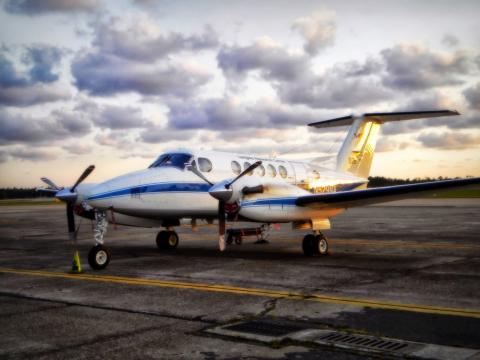
A multi-year airborne science mission is on its way to Texas to help scientists better understand how to measure and forecast air quality from space.
Change of Venue for NASA's IceBridge Antarctic Operations

For the first time ever, NASA's Operation IceBridge will fly scientific surveys out of McMurdo Station, Antarctica.
Learning by Doing: NASA's Airborne Research Experience for Educators

A dozen teachers from across the country came to Southern California for a 10-day Airborne Research Experience for Educators workshop at NASA Dryden.
Search On for Climate Clues Across Southern U.S. Skies

NASA research aircraft began flights Aug. 12 from Houston's Ellington Field to investigate how the combination of summer storms and rising air pollution from wildfires, cities, and other sources can change our climate. Hoping to improve future predictions of climate change, scientists in the NASA study are using the skies over much of the southern United States as a natural laboratory this month and into September.
Seeing Which Way the Wind Blows

A new Doppler radar takes flight on this summer's HS3 mission.
Airborne Campaign Preparing to Probe Pollution-Climate Link
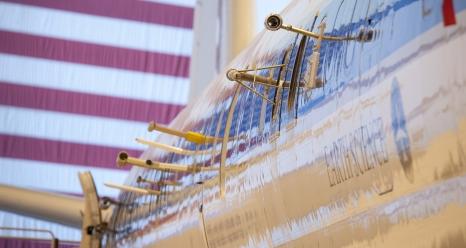
An eclectic assortment of sensors are installed on NASA's DC-8 and ER-2 aircraft to study how air pollution and natural emissions affect climate change.
Unmanned NASA Aircraft Crashes During Science Mission

NASA is investigating the loss of a small unpiloted aircraft over the Arctic Ocean Friday, July 26, while it conducted research on sea ice. The Sensor Integrated Environmental Remote Research Aircraft (SIERRA) was about four hours into a planned six-hour flight when it experienced a problem that caused it to lose altitude and crash in the ocean. The incident occurred at 6:15 p.m. AKDT (10:15 p.m. EDT).
The flight originated from Oliktok Point, off the northern coast of Alaska. The crash site is extremely remote, about 40 miles farther north in the Beaufort Sea. No one on the ground was injured. Environmental impacts at the crash site are expected to be minimal because of the aircraft’s small size. At the time, SIERRA had less than six gallons of fuel and oil aboard. A mishap investigation is underway.
The aircraft was one of three unmanned aerial vehicles taking part in a science experiment called the Marginal Ice Zone Observations and Processes Experiment (MIZOPEX). Mission objectives were to probe the ocean's role in recent declines in Arctic sea ice using a sophisticated set of radars and other instruments.
SIERRA was a medium-class, unmanned aircraft system with a wingspan of 20 feet and a weight of 400 pounds. It was designed to perform remote sensing and atmospheric sampling missions in isolated and often inaccessible regions, such as over mountain ranges, the open ocean, or the Arctic and Antarctic regions. NASA acquired SIERRA from the U.S. Naval Research Laboratory in 2006 and conducted its first mission surveying sea ice off the coast of Svalbard, Norway, in 2009. The vehicle was valued at $250,000.
For more information about SIERRA, visit:
http://airbornescience.nasa.gov/aircraft/SIERRA
For more information about the MIZOPEX mission, visit:
http://ccar.colorado.edu/mizopex/index.html
Ruth Marlaire
Ames Research Center, Moffett Field, Calif.
650-604-4709
J.D. Harrington
Headquarters, Washington
202-358-5241

